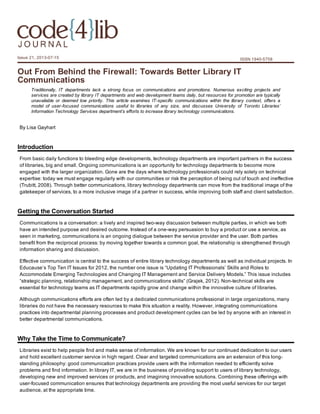
Out From Behind the Firewall: Towards Better Library IT Communications (Code4Lib Journal)
- 1. Issue 21, 20130715 ISSN 19405758 Out From Behind the Firewall: Towards Better Library IT Communications Traditionally, IT departments lack a strong focus on communications and promotions. Numerous exciting projects and services are created by library IT departments and web development teams daily, but resources for promotion are typically unavailable or deemed low priority. This article examines ITspecific communications within the library context, offers a model of userfocused communications useful to libraries of any size, and discusses University of Toronto Libraries’ Information Technology Services department’s efforts to increase library technology communications. By Lisa Gayhart Introduction From basic daily functions to bleeding edge developments, technology departments are important partners in the success of libraries, big and small. Ongoing communications is an opportunity for technology departments to become more engaged with the larger organization. Gone are the days where technology professionals could rely solely on technical expertise: today we must engage regularly with our communities or risk the perception of being out of touch and ineffective (Trubitt, 2008). Through better communications, library technology departments can move from the traditional image of the gatekeeper of services, to a more inclusive image of a partner in success, while improving both staff and client satisfaction. Getting the Conversation Started Communications is a conversation: a lively and inspired twoway discussion between multiple parties, in which we both have an intended purpose and desired outcome. Instead of a oneway persuasion to buy a product or use a service, as seen in marketing, communications is an ongoing dialogue between the service provider and the user. Both parties benefit from the reciprocal process: by moving together towards a common goal, the relationship is strengthened through information sharing and discussion. Effective communication is central to the success of entire library technology departments as well as individual projects. In Educause’s Top Ten IT Issues for 2012, the number one issue is “Updating IT Professionals’ Skills and Roles to Accommodate Emerging Technologies and Changing IT Management and Service Delivery Models.” This issue includes “strategic planning, relationship management, and communications skills” (Grajek, 2012). Nontechnical skills are essential for technology teams as IT departments rapidly grow and change within the innovative culture of libraries. Although communications efforts are often led by a dedicated communications professional in large organizations, many libraries do not have the necessary resources to make this situation a reality. However, integrating communications practices into departmental planning processes and product development cycles can be led by anyone with an interest in better departmental communications. Why Take the Time to Communicate? Libraries exist to help people find and make sense of information. We are known for our continued dedication to our users and hold excellent customer service in high regard. Clear and targeted communications are an extension of this long standing philosophy: good communication practices provide users with the information needed to efficiently solve problems and find information. In library IT, we are in the business of providing support to users of library technology, developing new and improved services or products, and imagining innovative solutions. Combining these offerings with userfocused communication ensures that technology departments are providing the most useful services for our target audience, at the appropriate time.
